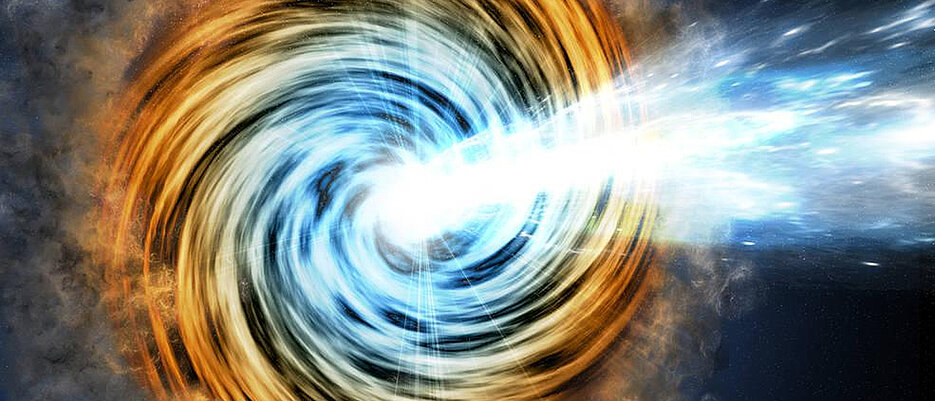New Insights Into Extraordinary Galaxies
06/19/2020Some galaxies may have two black holes at their centers. This is shown by the analysis of the gamma rays emitted by them. Würzburg astrophysicist Sara Buson was involved in the study.

A well established discovery from the last decades of astronomical observations is that most galaxies host a black hole at their center. “In general, these black holes are characterized by masses of more than a million masses of that of the Sun, thus they receive the name of supermassive black holes,” said Pablo Peñil, PhD student at Universidad Complutense de Madrid in Spain and lead author of a study that appeared in The Astrophysical Journal on Juni 17th, 2020. It’s title: “Systematic search for gamma-ray periodicity in active galactic nuclei detected by the Fermi Large Area Telescope”.
Particles with near the speed of light
“Some of these supermassive black holes, known as active galactic nuclei, or AGN, have been found to accelerate particles to near the speed of light in collimated beams called jets,” continued Peñil. “The emission from these jets is detected throughout the entire electromagnetic spectrum, but most of their energy is released in the form of gamma rays”. These gamma rays, which are the most extreme form of light, are detected by the Large Area Telescope on board NASA’s Fermi Gamma-ray Space Telescope.
AGN are characterized by abrupt and unpredictable variations in brightness. "Identifying regular patterns in their gamma-ray emission is like looking at the stormy sea and search for the tiny regular set of waves caused by, e.g., the passage of a small boat. It gets very challenging very quickly,” continued Peñil.
Search for periodicity in gamma rays
Thanks to a decade of Fermi-LAT observations, the team lead by Peñil was able to identify the repetition of gamma-ray signals over cycles of a few years. “Our study represents the most complete work to date on the search for periodicity in gamma rays, a study that will be instrumental to derive insights about the origin of this peculiar behaviour,” said Alberto Domínguez, Peñil’s PhD supervisor in Madrid and also co-author of the article. “We have used nine years of continuous LAT all-sky observations. Among the more than a two thousands AGN analyzed, only about a dozen stands out for this intriguing cyclical emission”.
“Previously only two blazars were known to show periodic changes in their gamma-ray brightness. Thanks to our study we can confidently say that this behavior is present in other eleven sources”, said Sara Buson, Professor at University of Würzburg in Germany, and also co-author of the paper. “In addition, our study found other thirteen galaxies with hints for cyclical emission but, to confidently confirm this, we need to wait for Fermi-LAT to collect more data”. Enlarging the limited sample of periodic emitters constitutes an important leap forward for understanding of the underlying physical processes in these galaxies.
Unravel the reasons behind these compelling observations
The team accomplished the first difficult step of identifying a large number of galaxies that emits periodically over years and is trying to address the question of what is producing that periodic behavior in these AGN. There are some fascinating explanations. “The next step will be the preparation of observational campaigns with other telescopes to follow-up closely these galaxies and hopefully unravel the reasons behind these compelling observations,” said Marco Ajello at Clemson University in South Carolina, USA, “We have in mind a few possibilities, from lighthouse effects produced by the jets to modulations in the flow of matter to the black hole, but one very interesting solution is that periodicity is produced by a pair of supermassive black holes rotating around each other. Understanding the relation of these black holes with their environment will be essential for a complete picture of galaxy formation,” continued Ajello.
Originalpublikation
Systematic search for gamma-ray periodicity in active galactic nuclei detected by the Fermi Large Area Telescope. P. Peñil, A. Dominguez, S. Buson, M. Ajello, J. Otero-Santos, J. A. Barrio, R. Nemmen, S. Cutini, B. Rani, A. Franckowiak, and E. Cavazzuti. The Astrophysical Journal. DOI: 10.3847/1538-4357/ab910d
Kontakt
Prof. Dr. Sara Buson, junior professor of astrophysics, sara.buson@astro.uni-wuerzburg.de






